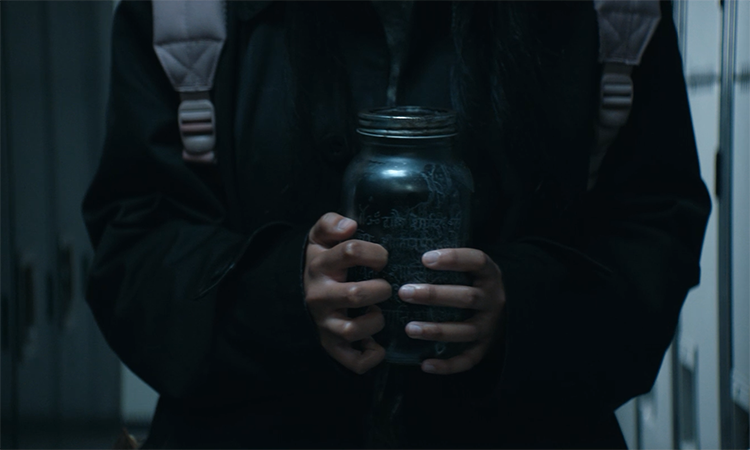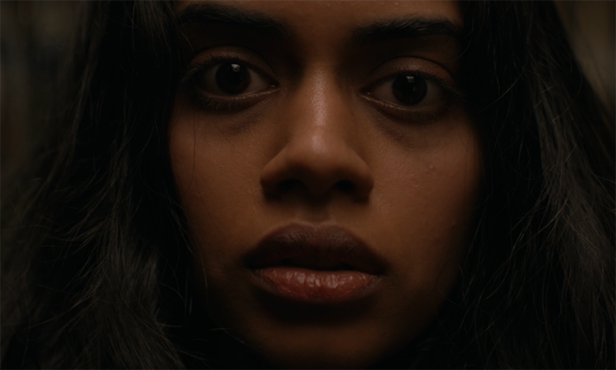Upcoming supernatural horror, It Lives Inside follows Samidha (Never Have I Ever’s Megan Suri) as an Indian-American teenager struggling with her cultural identity. When Samidha has a falling out with her former best friend, Tamira (Mohana Krishnan), she unwittingly releases a demonic entity that grows stronger by feeding on her loneliness.
The movie marks the first feature film from writer and director Bishal Dutta and we sat down with Dutta to discover how the story started with a tale told by his grandfather, what makes a good horror story and scaring audiences with a new nightmare-inducing monster…
How did everything begin for you with It Lives Inside?
A big thing for me was I wanted to honour the ghost stories that I heard growing up. My grandfather especially told a lot of these stories. I wanted to bring that to a Western audience because I felt like there was something so universal that it lasted through generations of my family.
Supposedly, when my grandfather was a young man in India, he went to a family friend’s house and their family friend’s daughter had a mason jar that she spoke to, and he was like, ‘hey, you know, there’s nothing in there right?’ and she got mad at him and she opened the jar and flung something at him but nothing came out.
My grandfather thought nothing of it, but then he started to be haunted. He’d hear knocking at all hours of the night, he’d hear voices, and at one point he left a pack of peanuts out and he heard chewing and when he turned around the peanuts were gone. So he left! He was out of there! [haha]
That story directly led to this movie but then when I was thinking about what that could have been, I was researching a lot of different entities and a lot of cultural mythologies about demons and ghosts. When I landed on the Pasha [demon], I felt like this was such a universal boogeyman and I felt like everybody could learn to be afraid of this thing.
Why tell a story in the horror space?
One of the things that I knew about the movie going into it was that I wanted to do a teen movie. When I was a teenager, I felt this conflict between being Indian and American and bridging the two parts of my identity. And I felt like that was a great conflict for a horror film.
I think horror as a genre allows us to, in a weird way, very realistically, express emotion. I think when you’re that age, you feel like you’re in a horror movie, so it felt like the most honest way to tell that particular story.
I felt like if I did it in any other genre or any other kind of dramatic format, the audience would feel outside of the main character’s emotions, but if you do it as a horror film, it feels like the audience can be right there inside her mind.
What were your horror inspirations?
If I were to tell you all the movies I stole from, we’d be here all night! But I’ll tell you a couple that were really big ones.
First and foremost, the Nightmare on Elm Street movies. Certainly one and two were the big ones. One you can totally see, but two is such an interesting film. It’s so layered and textured and it has the subtext about coming out. But supposedly, most of the people making the movie didn’t know about it. So I was really drawn to this idea of how you unselfconsciously make a horror film but still bake these ideas into it.
I was also thinking a lot about Christine, the John Carpenter movie. That was one that I felt afforded so much complexity and depth to the teenage experience. Gingersnaps was another big one. That was a film that I was so influenced by because it so perfectly combines the coming-of-age thing, the teen angst with the horror, the werewolf transformation.
We could go on and on but it’s that kind of Amblin-adjacent horror film that really inspired me for this. Poltergeist as well is another big one. This idea of what lives beneath the surface of the suburbs, especially those Spielbergian suburbs…

You have some brilliant young actors in It Lives Inside – how closely did you work with Megan and Mohana for their roles in the movie?
They are tremendous actors. We tried to talk about real people in our lives because the aesthetics of the film are about building that kind of horror-scape, the characters needed to feel like real people. I was drawing from family members and friends and distant relatives and just real people in the community.
So we just talked a lot about the humanity of the characters and it was such a privilege for me when we were shooting the film, to be able to step back. Every filmmaker dreams of their actors knowing their characters better than they do, and I felt like I had that in this movie. They were able to bring such humanity to every beat of their performances.
You say some of this movie came from your own experiences – what was it like working through the process of making this film when it comes from such a personal place?
It’s what I love to keep doing. The most fun part of the filmmaking process is that the more specific you get, the more universal it feels.
This particular feeling that I had growing up, that some of my friends and family had… it felt as if we could capture it. It wasn’t just going to appeal to Indian Americans or immigrants. It feels like today, a lot of us feel caught between two worlds and multiple identities and how we bridge those gaps within ourselves. So the more specific that I could get about it, without trying to make a statement on behalf of the Indian American diaspora, I was just trying to pull from real things that I remember. Little stuff, like she runs out of the house and she sniffs herself to make sure she doesn’t smell like Indian food. Little stuff like that. I felt like if I could just pull the audience in a very immersive and non-educational way, just put them inside the world, that would be the most gratifying thing for an audience.
For me, I got to recreate some things from my childhood, like the Puja party sequence. My parents had wonderful Puja parties and so just getting those costumes right, the decorations and the food and then letting the camera really exist inside of that… I look at it and I’m like ‘oh, this is great. I remember this’ and now I can share that with other people. So it’s very positive. It’s very gratifying as a whole.
How did you make sure you kept the balance right between a gory horror movie and a genuine story about cultural identity and family?
Well, I think first and foremost, I love horror movies and I love the communal experience of horror movies. I remember going to see The Conjuring when that first came out. I was a teenager and we would just go with all my friends and scream and laugh, so I wanted to create that kind of communal, theatrical, horror experience.
We were always very conscious of that. But I think the reality is also that if you only give an audience that, they leave feeling a little bit empty.
So I think the balance comes from satisfying what the audience came here to see, but even after satisfying that, we actually have a lot of real estate left to explore character and to get into the real stuff. So I think it’s just one of those things where a movie can be so many things. I always knew that there was space for this movie to be both of those things.
There’s a brilliant creature in It Lives Inside – how involved were you in creating it?
I was stoked to do this creature. I love practical creatures. It was one of those things about this movie that I was most excited about. I got to work with an amazing creature designer, Todd Masters, he’s brilliant. He did the Borg Queen in Star Trek: First Contact. The guy’s great.
I came in with a lot of ideas, with hundreds of images of what I wanted and so it was this flurry of inspiration. I always wanted it to be evil. But we started a lot from the cultural art that exists about the creature and then said, ‘okay, this is an interpretation, but how do we bring this into three dimensions? How do we make it feel physical and threatening and real?’
We were also pulling a lot from some of my favourite horror films, especially the practical gooey effects of something like Pumpkinhead, The Fly or Aliens. These are movies that I remember having such an effect on me because they felt so real.
How did you decide on how much of the creature you’ll show in the movie?
Well, I’m certainly not original in saying that I was influenced by Jaws and Alien with the approach but I think with this particular creature, with it being this embodiment of fear, my thinking was that if we can suggest its presence, and we can suggest its speed and ferocity, you get to believe that something’s there but not show it to you directly. My thought was that the audience could project their own worst fears into it. I always think that’s a little bit scarier.
What do you want audiences to take away from It Lives Inside?
Well first and foremost, I hope they’re scared. That would be great. It was really made to be the kind of movie that as a teenager I just loved seeing in the movie theatre; those big intense scares and laughing with your friends because you were so scared. I hope that it does that.
But beyond that, if it makes anybody feel that it’s okay to be many things, that your identity can be comprised of a lot of different things, and that there’s an opportunity to find balance among all those pieces of your identity, that, to me, is what the film is about. If anybody leaves this film encouraged to do that, I’ll feel happy with the movie and how the audience received it.
It Lives Inside will be released in UK cinemas on 20 October. Read our review here.




